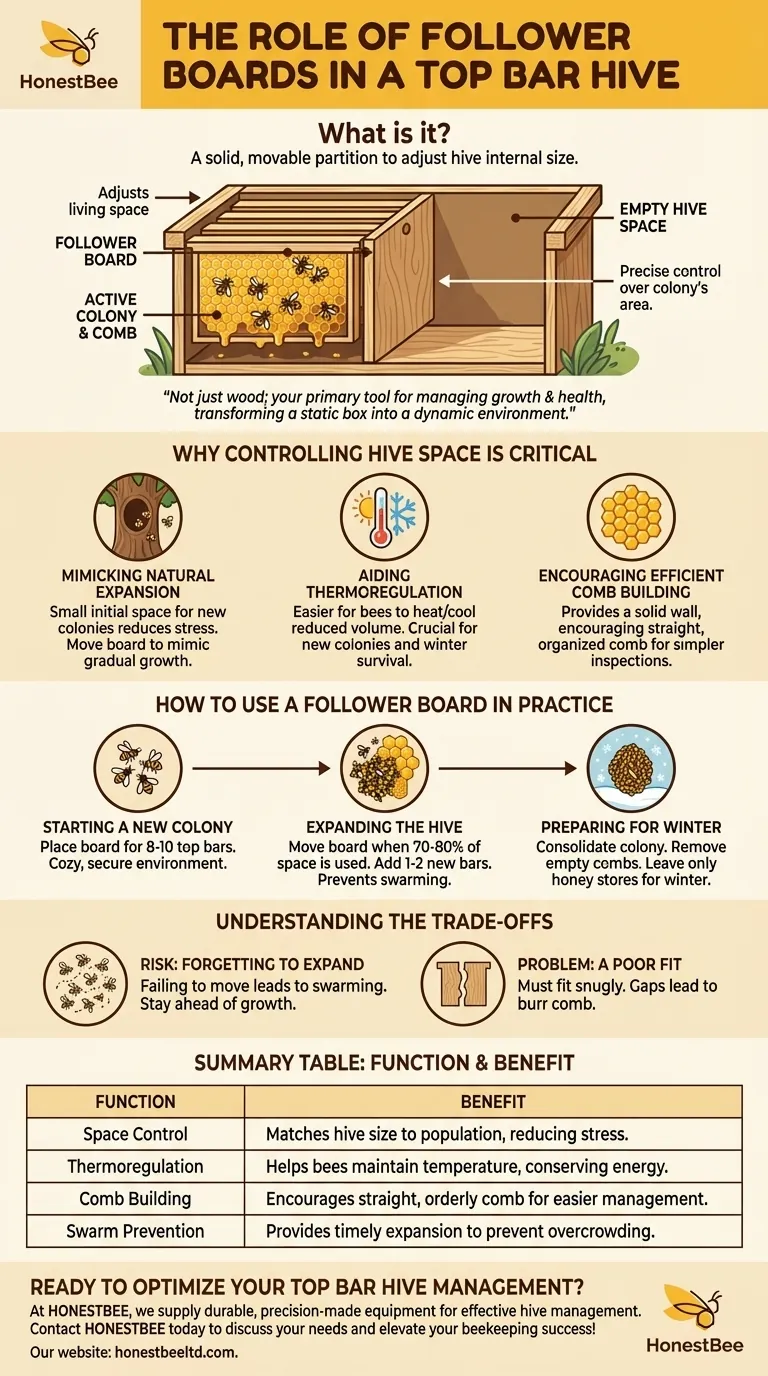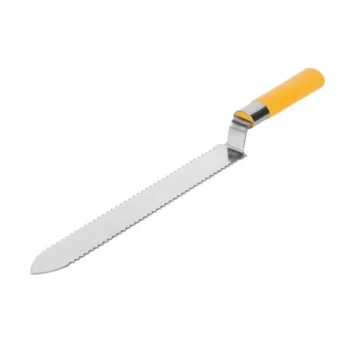A follower board in a top bar hive is a solid, movable partition used to adjust the internal size of the hive cavity. Its primary role is to give the beekeeper precise control over the colony's living space, confining the bees to an area that matches their current population size.
At its core, the follower board is not just a piece of wood; it is your primary tool for managing a colony's growth and health in a horizontal hive. It transforms the hive from a static box into a dynamic environment you can adapt to the bees' changing needs.

Why Controlling Hive Space is Critical
In a traditional vertical Langstroth hive, space is managed by adding or removing entire boxes. In a horizontal top bar hive, the follower board accomplishes the same goal with much more nuance and control.
Mimicking Natural Expansion
A new or small colony in a vast, empty hive can become stressed. They must work harder to defend their territory from pests and regulate the internal temperature.
The follower board allows you to provide a small, manageable space initially. As the colony grows, you can move the board one bar at a time, mimicking the gradual expansion of a natural bee colony in a hollow log.
Aiding Thermoregulation
Bees must maintain a stable temperature and humidity in the brood nest, which requires significant energy.
By using a follower board to reduce the volume of the hive, you make it much easier for the colony to heat and cool their living space. This is especially crucial for new packages and for helping a colony survive winter.
Encouraging Efficient Comb Building
Bees prefer to build comb in a contiguous, organized manner. An overly large space can lead to scattered, haphazard comb construction.
The follower board provides a solid wall that encourages the bees to build straight, orderly comb on the adjacent top bars, making hive inspections and management much simpler.
How to Use a Follower Board in Practice
The follower board is an active management tool that you will adjust throughout the beekeeping season.
Starting a New Colony
When installing a new package or nuc, place the follower board to give the bees just enough space for about 8-10 top bars. This creates a cozy, secure environment for them to get established.
Expanding the Hive
As you inspect the hive, you will see the bees begin to build comb on the last available top bar next to the follower board.
Once they have drawn out 70-80% of the comb in their current space, it's time to move the follower board down and add one or two new, empty top bars. This provides room for growth and helps prevent swarming.
Preparing for Winter
In the fall, you can use the follower board to consolidate the colony. Remove any empty combs from the back of the hive and move the board forward, leaving the bees with just the honey-filled combs they need to survive the winter.
Understanding the Trade-offs
While essential, follower boards require active management to be effective.
Forgetting to Expand is a Risk
The most common mistake is failing to move the follower board as the colony grows. If the bees run out of space, their natural instinct is to swarm.
You must stay ahead of the colony's growth curve, especially during a strong spring nectar flow, by providing new bars before they feel crowded.
A Poor Fit Creates Problems
A follower board should fit snugly against the slanted sides and bottom of the hive.
If there are large gaps, bees may build burr comb in the spaces or treat the follower board as just another part of the hive, defeating its purpose as a boundary.
Making the Right Choice for Your Goal
Your use of the follower board will change based on your colony's needs and the time of year.
- If your primary focus is establishing a new colony: Use the follower board to create a small, easily defensible space that conserves the bees' energy.
- If your primary focus is managing a growing colony: Move the follower board incrementally to provide space just before the bees need it, encouraging steady growth and preventing swarming.
- If your primary focus is preparing for winter: Use the follower board to reduce the hive volume, helping the cluster stay warm and conserving their honey stores.
Ultimately, the follower board empowers you to manage your hive in a way that closely aligns with the natural instincts of the honey bee.
Summary Table:
| Function | Benefit |
|---|---|
| Space Control | Matches hive size to colony population, reducing stress. |
| Thermoregulation | Helps bees maintain temperature, conserving energy. |
| Comb Building | Encourages straight, orderly comb for easier management. |
| Swarm Prevention | Provides timely expansion to prevent overcrowding. |
Ready to optimize your top bar hive management? At HONESTBEE, we supply commercial apiaries and beekeeping equipment distributors with the durable, precision-made supplies needed for effective hive management. Whether you need top bar hive components or other essential equipment, our wholesale-focused operations ensure you get reliable gear for healthier, more productive colonies. Contact HONESTBEE today to discuss your needs and elevate your beekeeping success!
Visual Guide

Related Products
- HONESTBEE Round Hive Top Bee Feeder for Syrup
- Professional Drop-Style Hive Handles for Beekeeping
- In-Hive Dual Compartment Frame Bee Feeder for Targeted Colony Nutrition
- HONESTBEE Entrance Bee Feeder Professional Hive Nutrition Solution for Beekeeping
- Boardman Entrance Bee Feeder Durable Galvanized Steel and Wood Construction for Beekeeping
People Also Ask
- What can the round hive top feeder be used for? A Guide to Efficient, Safe Bee Feeding
- What are the features of top feeders for bees? Maximize Hive Health with Safe, High-Capacity Feeding
- What types of hive boxes is the round hive top feeder compatible with? Universal Fit for 8 & 10-Frame Langstroth Hives
- What features make top feeders a reliable choice for beekeepers? A Guide to Safe, Efficient Hive Nutrition
- How should syrup for bees be prepared? Master the Ratio for a Thriving Hive



















